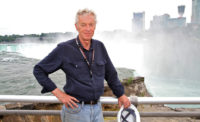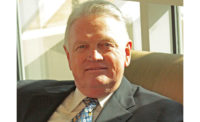It’s not uncommon for design professionals to specialize in a particular niche, or even to choose one building type as their favorite. But Dave Hammel of Denver’s Barker Rinker Seacat Architecture (BRS) has done more than find a niche and excel at it; he has helped more than 250 communities plan and design their recreation centers while identifying cutting-edge innovations that have shaped this particular specialty along the way.
“Dave found the community center building type to be very satisfying,” says BRS principal Craig Bouck. “It’s the only building the whole community can find value in for their entire lives. No matter your age, you can go there every day and find a connection—whether for health, education or socialization.”
Hammel’s design career began as an intern with BRS while he was in graduate school at the University of Colorado. He became a principal with the firm in 1988, and ultimately spent his entire 43-year career there. Hammel retired from BRS earlier this year with the distinction of being a nationally recognized specialist in the design and planning of community recreation centers.
Iconic Firsts
The Westminster Recreation Center in Westminster, Colo., was the first rec center Hammel designed and the first for BRS. “No one had tried to put a water park facility indoors,” says Hammel. “We toured facilities in Europe to see what was going on, ultimately creating the first ‘supercenter’ in the U.S.”
Westminster was also the first indoor leisure center and featured the first indoor climbing wall in the country. “We weren’t sure exactly how to do it,” he says, referring to the climbing wall.
He hired a rock climber from Boulder to work with a masonry contractor on designing a rock wall with components that could help teach the basics of rock climbing. They worked under a tent with heaters through the winter to determine how to place cracks, overhangs, handholds and different climbing routes of varying difficulty. The project provided national exposure for BRS and helped establish climbing walls as key components in many rec centers; today they are as common as indoor pools.
A dozen or so rec centers later, Hammel inspired the design of the 160,000-sq-ft Apex Center in Arvada, Colo. Intended to be an all-day destination center for families, it is the second-largest public recreation center west of the Mississippi River. Completed in 2000, the rec supercenter boasts two NHL-sized indoor ice arenas; a themed aquatic center with two slides, a pool and play structures for toddlers; a teen pool for water basketball; lanes for swimming laps; three gymnasiums; and two spas—one for adults and one for families.
Problem Solver
One of the biggest challenges with aquatic facilities is design of the building envelope, which requires keeping cold and moisture out and preventing damage from snow or rain to the internal walls.
“There are many penetrations where that could break down, and Dave used his expertise and graphic ability to figure out and solve those problems,” says pool consultant Doug Whiteaker, president of Water Technology Inc. He has worked with Hammel on more than 100 projects over the last 20 years and credits him for his unique blend of architecture, engineering insight and artistry.
“We toured facilities in Europe to see what was going on, ultimately creating the first ‘supercenter’ in the U.S.”
– Dave Hammel, Principal, BRS
“His greatest talent is to be able to graphically create the details to illustrate technical information, so that even those who don’t understand the problem can understand the solution. He’s good at taking complex challenges and breaking them down into doable solutions,” Whiteaker says.
Those challenges can take several forms. Rec centers with pools use more energy than any other public building because many are open from 5:00 a.m. to 10:00 p.m. for the public and then open all night for cleaning. Also, the vastly different activity zones require extensive design expertise, and there’s the challenge of creating a building for users with a variety of ages and needs that might not normally coincide. For example, the pool area must be kept warm and humid, the fitness center air conditioned and the meeting rooms quiet.
“There are always challenges, but Dave’s nature never got emotional or reactive,” adds Whiteaker. “He’s very analytical and asks: ‘What’s the source? The solution?’ He would calm the clients down and get them a reasonable response, so everyone trusted him.”
With Hammel’s guidance, BRS created many innovations for how rec centers function, including designing the first-ever LEED certified rec center in the country, the North Boulder Recreation Center, which also was the first LEED Silver project in Colorado.
BRS also introduced the idea of using secondary water treatment for swimming pools. Up until 1985, all pools were treated only with chlorine. After the Westminster Rec Center, Hammel advised clients he would not design another pool without a secondary treatment option.
“We started with an ozone system, injecting ozone into the water, in addition to chlorine. Then we moved to an industrial-grade ultraviolet light, which circulates all of the water that goes through the filters to kill the bacteria. This has made all the difference in eliminating that chlorine smell completely, and it’s the system we’re still using today,” Hammel says.
Active Adults
The Fort Collins Senior Center in Fort Collins, Colo., was BRS’s first senior center, and is one of the first active adult centers built in the U.S. It’s a market segment BRS still pursues. One of the last designs of Hammel’s career, the Thornton Active Adult Center, was completed in July 2020, just as he was retiring.
“Dave is the guy you go to if you have a tough problem, or even if you just need to talk.”
– Keith Hayes, Partner, BRS
“What’s great about working with Dave is his deep commitment to engaging the community,” says Lisa Ranalli, the center’s program manager. Ranalli also worked with Hammel on the planning and design of the new Trailwinds Rec Center in Thornton, Colo., which opened in spring 2019.
“He’s a great listener and he has a lot of passion for creating these wonderful community spaces. Each place BRS designs is unique to its community, and you can only accomplish that by listening to the people who work there and those who will use the facility,” she says.
Bouck adds: “Not only did [the Thornton Active Adult Center] have to look good, but it also had to function well, and this speaks to his approach to a project—not just getting it built but also staying connected during the life of the project so that it can evolve and change and be relevant to the community it lives in.”
Renaissance Architect
“In this business, the push is for specialization—to differentiate yourself from your competition and everyone else. The narrower you become, the better,” Bouck says. “Even though community recreation was his focus, Dave kept a balance of keeping his fingers in design, paying attention to client management, mentoring BRS staff and enjoying the process of running a business too. It’s a difficult balance to maintain. In this world of specialization, he’s found a way to remain a Renaissance architect.”
“I’ve always felt if you do a good job and go the extra mile, it will pay dividends in the end,” Hammel says. “Ultimately, [the project] is about a building, but it’s also about all the people you work with along the way. You go through this whole process of design, planning, construction documents, picking carpet, floors and wood. Then one of the first things I hear from them once they get it operational: ‘I want to do it again!’” he says. “Many of these folks start looking for a new job where they can do that. Part of the joy is the process, and I’d like to think we had something to do with it.”
“Dave is the guy you go to if you have a tough problem, or even if you just need to talk,” adds Keith Hayes, a BRS partner. He says he was “just a wee architect” when Hammel hired him in the 1990s and took him under his wing for the Apex project, kicking off a long mentor-mentee relationship. “Anytime you sat down with him, he would stop what he was doing, look you straight in the eye and talk to you,” Hayes says.
Hammel also is known for his tendency to dig into a problem and not let go. His final project, the $54-million Northglenn Recreation Center, Senior Center and Theatre in Northglenn, Colo., is currently under construction. He started the conceptual design process for the building nearly 18 years ago, but the project couldn’t find enough funding and was put on hold. Hammel didn’t give up, and now the 87,000-sq-ft building will be twice the size of the current facility and includes a 300-seat performing arts center, a unique concept for this type of venue.
“Dave leads by example, prioritizing people first,” Bouck says. “He was unflappable and approached decisions, even when times were tough, with level-headed calmness and a perspective of respect, fairness and kindness. From here on out, as firm leaders we will always be thinking: ‘What would Dave do?’”










Post a comment to this article
Report Abusive Comment